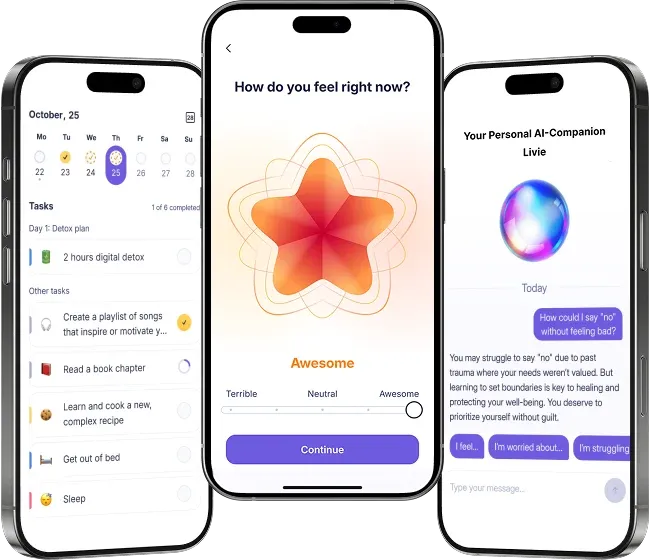How to Stop Procrastinating: Understanding the Cycle and 10 Effective Strategies

Procrastination is one of the most common struggles of our time: studies show that around 20-25% of adults struggle with procrastination. Yet despite how widespread it is, procrastination is still often mistaken for laziness.
Think of procrastination as a credit card. You get instant relief now by avoiding the task but pay interest later in the form of stress and last-minute panic. What feels like a break in the moment piles pressure onto your future self.
The good news is, once you understand that procrastination is an emotional regulation problem, you can break the cycle.
In this guide, we’ll unpack why procrastination happens and share 10 proven strategies to stop procrastinating and finally move forward with clarity and confidence.
Key Learnings
- Procrastination is an emotional regulation issue that can be managed with the right tools.
- Short-term hacks help you start (like the 2-minute rule or Pomodoro), but long-term systems prevent relapse.
- Different types of procrastinators need different fixes: perfectionists, avoiders, and “crisis-makers” all benefit from tailored strategies.
- Using tools like journaling, mood tracking, or routine builders makes change sustainable.
Procrastination vs. Laziness: What’s the Difference?
People often confuse procrastination with laziness, but they’re not the same thing.
- Laziness is indifference. A lazy person simply doesn’t care about the task or its consequences. They’re comfortable with inaction and don’t beat themselves up for it.
- Procrastination is avoidance mixed with guilt. A procrastinator usually wants to do the task (and feels bad for not doing it), but gets stuck in delaying because of fear, perfectionism, or emotional discomfort.
That’s why procrastination feels exhausting: you’re not resting, you’re battling an inner tug-of-war between “I should be doing this” and “I don’t want to face it right now.”
To summarize, laziness is passive indifference, procrastination is active self-sabotage.
The Procrastination Cycle
Understanding this cycle is the first step to breaking it. Here are the five stages most procrastinators know all too well:
Task Avoidance
You stare at the task and instantly feel tension. Deep down, it feels like your performance equals your worth — so what if you fail? To protect yourself from possible criticism, you avoid starting. Common trigger: perfectionism. The higher your standards, the scarier it feels to begin.
Short-Term Relief
Avoiding the task brings temporary comfort. You tell yourself: “I’ll start when I have more time/energy/clarity.” The task feels too important to risk getting wrong, so you push it off, convincing yourself delay is “strategic.” Hidden cost: every delay strengthens the habit of avoidance.
Rising Stress & Anxiety
The longer you wait, the heavier the task becomes. Anxiety spikes, adrenaline floods your system, and the task starts to feel dangerous. Instead of calming you, the relief of avoidance backfires — now you’re more stressed and further behind.
Crisis Point
The deadline looms. Panic overrides hesitation, and you finally start, but under crushing pressure. Some people even feel a burst of adrenaline-fueled energy here, convinced they “work best at the last minute.” But in reality, this mode is unsustainable and often leads to burnout.
Regret & Shame
The task gets done but usually rushed, under-slept, and below your best standards. Feedback (or even your own self-criticism) reinforces shame. You promise yourself you’ll “do better next time”… and the cycle quietly resets.
10 Proven Strategies to Stop Procrastinating
Procrastination doesn’t vanish with willpower alone. It takes a mix of quick tricks to get moving, long-term systems to stay consistent, and emotional tools to handle the feelings that drive delay. Here are ten strategies you can start applying today.
⚡ Quick Start Tactics (for Immediate Action)
1. Use the 2-Minute Rule to outsmart resistance
At its core, procrastination is about the weight we attach to starting. The 2-Minute Rule flips that script: if something takes less than two minutes, do it right now. Send the email. Rinse the dish. File the document.
The real power of this rule is in tricking your brain into motion. Starting a task (even for two minutes) reduces the mental friction that makes it feel overwhelming. Often, those two minutes snowball into 20, 30, or more without effort.
Variations worth trying:
- Gateway version: Commit to just two minutes of a bigger task (“I’ll write one sentence”). Once you’ve started, momentum usually carries you forward.
- Clean-slate version: Do two-minute resets between bigger tasks (clear your desk, stretch, jot quick notes). This lowers transition friction.
- Batching version: Group a handful of two-minute tasks into a “mini-sprint” so they don’t clutter your mental to-do list.
2. Adapt the Pomodoro Technique to your brain
The classic Pomodoro Technique (25 minutes of focus, 5 minutes of rest) is a great starting point. But here’s the truth: it doesn’t work the same for everyone. What matters is less the timer itself and more the psychology behind it: creating urgency, lowering resistance to starting, and rewarding your brain with regular breaks.
That means you can (and should) adapt Pomodoro to your own rhythms:
- Flowmodoro: Extend your focus block to 50-90 minutes if you’re “in the zone,” then take a longer break.
- Reverse Pomodoro: Start with a short break before the task to ease your brain into focus mode.
- Team Pomodoro: Pair up with a friend or colleague, working in synchronized sprints for built-in accountability.
Why it works?Micro-deadlines reduce decision fatigue, breaks reset your energy, and the structure taps into dopamine circuits — making focus feel more rewarding.
3. Break big tasks into micro-steps
“Finish report” is vague and overwhelming. “Draft outline” or “write intro paragraph” is clear and doable. Chunking large projects into micro-steps lowers resistance and makes progress visible.
Long-Term Systems (Build Momentum)
4. Prioritize with the Eisenhower Matrix
Not all tasks deserve your attention. The Eisenhower Matrix helps you decide:
- Important + urgent → Do now.
- Important, not urgent → Plan.
- Urgent, not important → Delegate.
- Neither → Delete.
This shift from “everything feels urgent” to “what truly matters” frees you from busywork disguised as productivity.
5. Build routines & design your environment
Procrastination thrives in chaos. Create predictable cues that make starting automatic: same workspace, same start ritual, same time. And design your environment to help you: silence notifications, keep your desk clear, remove temptations before they hijack your focus.
6. Track progress and celebrate small wins
What gets measured improves. Tracking your focus sprints, daily starts, or tasks finished makes progress visible. Visible progress motivates more action.
Emotional and Mindset Tools (Address the Root)
7. Practice self-compassion over self-criticism
Most procrastinators beat themselves up: “Why can’t I just do it?” That shame actually fuels more avoidance. Research shows that self-compassion reduces procrastination by lowering anxiety. Replace “I’m lazy” with “I’m learning to start small.”
8. Use mindfulness and relaxation techniques
When a task feels threatening, your brain triggers fight-or-flight. A few minutes of deep breathing, meditation, or progressive muscle relaxation calms your nervous system so the task feels less overwhelming.
9. Reframe fear of failure
Perfectionism says: “If it’s not flawless, it’s worthless.” That mindset keeps you from starting. Reframe it: “Done is better than perfect.” Or even better: “Every imperfect draft is data I can improve on.” Failure becomes feedback instead of a verdict.
10. Lean on accountability and support
Humans are social creatures — we show up when someone else is watching. Share your goals with a friend, join a body-doubling study session, or use an accountability app. The simple act of telling someone your plan increases your odds of following through.
Don’t try to master all 10 at once. Start with one quick tactic, one system, and one mindset shift. That mix is enough to cut through resistance today and build resilience for tomorrow.
Can Procrastination Ever Be Productive?
Most of the time, procrastination drains energy and hurts performance. But under certain circumstances, it can have a silver lining. Psychologists call this “productive procrastination”, when delaying one task gives your brain space to process ideas, incubate solutions, or shift focus to lower-stakes work.
Think of it like this: while you fold laundry or take a walk instead of tackling a complex project, your subconscious is still turning over the problem in the background. When you return, you may have a clearer perspective or a creative breakthrough.
That said, productive procrastination works best when it’s intentional, short-term, and balanced with action. Waiting until the last minute for the adrenaline rush may produce results in the short run, but it often leads to stress, burnout, and lower-quality work.
A Quick Test: Is My Procrastination Productive?
Ask yourself these three questions:
- Am I giving space for ideas? (e.g., stepping away to let my brain connect dots in the background).
- Am I avoiding discomfort? (e.g., putting it off because the task feels scary or overwhelming (warning sign)).
- Am I chasing adrenaline? (e.g., waiting until panic kicks in to force action (unsustainable)).
How to Measure Your Progress
- Track frequency: Note how often you catch yourself procrastinating each week. Even a small reduction means progress.
- Track time reclaimed: Keep a log of how much focused time you gained back by starting tasks earlier.
- Track mood changes: Use a mood tracker or journal to reflect: Do I feel less stressed? More satisfied? Emotional shifts are just as important as productivity gains.
Journal prompts to try:
- When did I catch myself procrastinating today? What triggered it?
- What small action helped me start anyway?
- How did I feel afterward compared to before?
Frame it as progress, not perfection. Even noticing your patterns is a win. Small shifts compound into lasting change.
Final Thoughts: Small Steps Beat Big Delays
If you struggle with procrastination, you’re in good company — nearly everyone does. But here’s the important truth: procrastination isn’t a fixed trait, it’s a pattern. And patterns can change.
The key isn’t tackling everything at once. It’s proving to yourself that you can take one small step today. Each action, no matter how tiny, is a vote for your future self, the one who feels lighter, more confident, and more in control.
Start with one strategy from this guide — a two-minute task, a focus sprint, or a single journal entry. Those small steps add up to big shifts over time.
Bonus: Additional Resources
If you want to dive deeper into procrastination and motivation, these trusted resources are worth exploring:
- Podcast: Mel Robbins – How to Stop Procrastinating. A practical, no-nonsense take on why we delay and simple tools to break free from the habit.
- Article: James Clear – How to Stop Procrastinating. A science-backed deep dive into the psychology of procrastination, including strategies like the 2-Minute Rule and environment design.
- Essay: Tim Urban – Inside the Mind of a Master Procrastinator. A witty, illustrated breakdown of procrastination that went viral and inspired one of the most popular TED Talks on the topic.
- Talk: Brené Brown – The Power of Vulnerability. While not exclusively about procrastination, Brené’s work on shame and vulnerability reveals why self-criticism often fuels avoidance — and how compassion helps us act.
References
- McLean Hospital. (n.d.). The science of procrastination and how to manage it. McLean Hospital. https://www.mcleanhospital.org/essential/procrastination
- Raypole, C. (2022, March 23). Procrastination in the digital age: Why it happens and how to overcome it. Healthline. https://www.healthline.com/health-news/procrastination-digital-age

